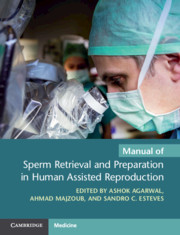Book contents
- Manual of Sperm Retrieval and Preparation in Human Assisted Reproduction
- Cambridge Laboratory Manuals in Assisted Reproductive Technology
- Manual of Sperm Retrieval and Preparation in Human Assisted Reproduction
- Copyright page
- Dedication
- Contents
- Contributors
- Editor Biographies
- Preface
- Part I Introduction
- Chapter 1 Anatomy and Physiology of the Male Reproductive System
- Chapter 2 Evaluation of Candidates for Sperm Retrieval
- Chapter 3 Testicular Histopathology and the Role of Testis Biopsy
- Part II Sperm Retrieval
- Part III Laboratory Handling of Retrieved Sperm
- Index
- References
Chapter 3 - Testicular Histopathology and the Role of Testis Biopsy
from Part I - Introduction
Published online by Cambridge University Press: 09 April 2021
- Manual of Sperm Retrieval and Preparation in Human Assisted Reproduction
- Cambridge Laboratory Manuals in Assisted Reproductive Technology
- Manual of Sperm Retrieval and Preparation in Human Assisted Reproduction
- Copyright page
- Dedication
- Contents
- Contributors
- Editor Biographies
- Preface
- Part I Introduction
- Chapter 1 Anatomy and Physiology of the Male Reproductive System
- Chapter 2 Evaluation of Candidates for Sperm Retrieval
- Chapter 3 Testicular Histopathology and the Role of Testis Biopsy
- Part II Sperm Retrieval
- Part III Laboratory Handling of Retrieved Sperm
- Index
- References
Summary
Testicular histopathology has been found to be the most reliable predictive factor of successful sperm retrieval in nonobstructive azoospermia patients. Some studies have proposed performing a diagnostic biopsy before assisted reproductive technology. However, its application in clinical practice has been debated due to some criticisms, including its cost-ineffective nature. Another important advantage of histopathology is the revealing of germ cell neoplasia in situ, which occurs in 1–3 percent of infertile patients. Testicular histopathology also offers important information in cases of failed sperm retrieval. When areas of active spermatogenesis are found, the histological pattern could guide the clinician in choosing the more suitable therapeutic option.
- Type
- Chapter
- Information
- Publisher: Cambridge University PressPrint publication year: 2021

